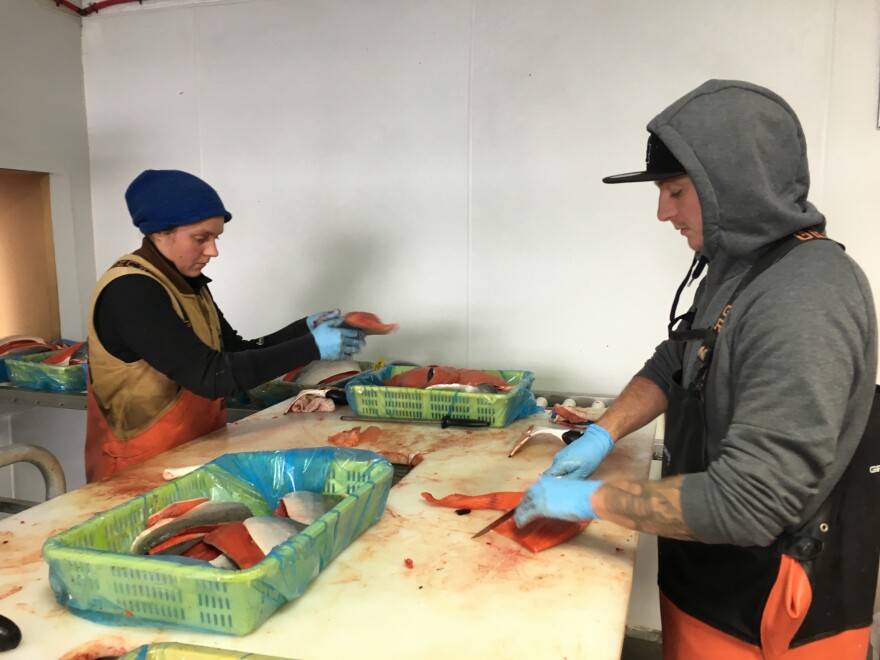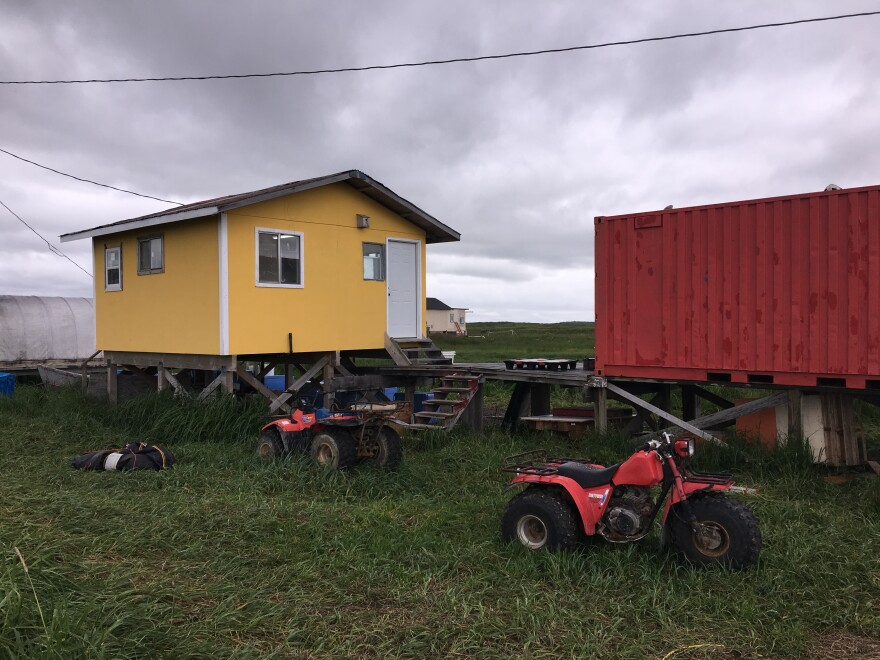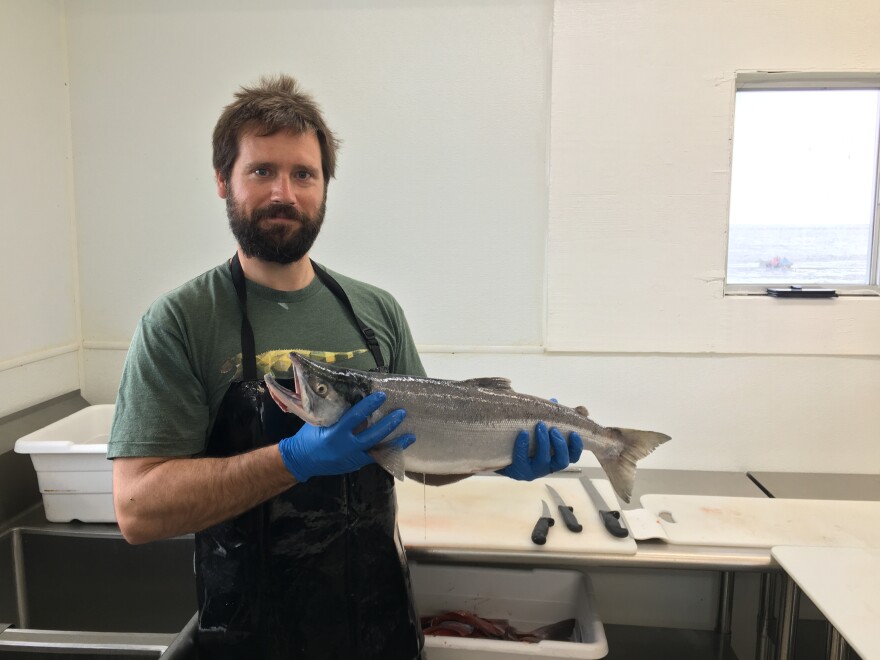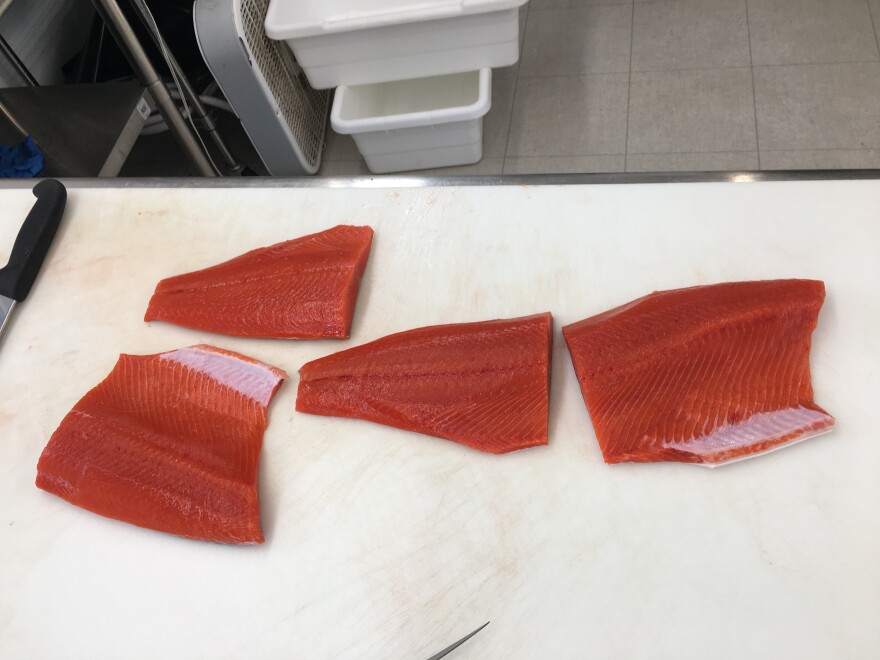Large seafood companies buy and sell most of the sockeye caught every summer in Bristol Bay, but there are a lot of small businesses that sell fillets right to customers all over the country and finding some success doing it. KDLG visited some of these small processors to talk shop.
The majority of processing seafood companies in Bristol Bay are small Mom and Pop shops who are essentially the roadside farm stands of the Bristol Bay sockeye fishery selling sockeye directly to customers. But these businesses only sell a fraction of the sockeye caught in the region.
Standing in a shipping container that’s been converted into essentially a salmon butchery. Sandy Alvarez is filleting a sockeye. People regularly admire her technique but she said the secret behind it is practice.
“Well you know people who comment they wish they could do that I usually laughingly tell them. ‘Try doing 1,500 fish for 10 years you probably can!'”
Almost a decade ago Alvarez and her husband, a commercial fisherman, set up a little processing plant near their summer home in Naknek. Alvarez’s husband fishes for sockeye and drops off a bit of his catch to his wife who then processes it. Then he sells the rest of his salmon to a larger seafood company. That is pretty typical for small seafood processors in the region.

The Alvarez family decided to start My Girl Fisheries because they heard tourists complain there was nowhere to buy salmon to take home.
“They said, 'You can’t even buy a fillet in the salmon capital of the world,'” Alverez recalled.
Now she sells sockeye to those tourists and to local fishing lodges.
Larger processors in the region, ones that go through more than a million pounds of sockeye in a season, sell in bulk to places like grocery store chains and restaurants. That’s why it used to be hard for people just passing through to buy a few pounds of sockeye.
Even though operations like Alvarez's don’t come close to the big guys, some used to look at processors like hers as a threat. Alvarez thinks that is ridiculous.
“Sometimes they think you’re going to be competition, but, you know, dream on. I can’t do more than 2,000 fish in a summer ever.”
Small processors make up the majority of seafood companies in the region, but they deal with a tiny fraction of Bristol Bay’s sockeye.
According to the Alaska Department of Fish and Game, last year there were about 30 small processors. Altogether, they only bought and sold about a million pounds of sockeye. That is less than one percent of the 208 million pounds caught that season. The hundreds of millions of pounds of salmon leftover were processed by the 17 largest seafood companies in Bristol Bay.

Alvarez said as time passes some larger processors are seeing how operations like hers can coexist symbiotically.
“It’s only is going to benefit them in the end because, you know, when I run out, the people I have who like salmon are going to go looking for some more.”
Down the road from Alvarez is the Kvichak Fish Company. It is bigger than Alvarez’s shop and its employees are jamming out to music as they cut a few thousand pounds of fish a day. Amanda Walaysewski is one of the owners and she said if her workers didn’t have their music they’d revolt. Their favorites include:

“Guns & Roses, definitely Tupac, a little bit of dubstep late at night, and rap, which I think they do just to embarrass me when customers and fishermen come in.”
Walaysewski said the stakes for smaller processors is smaller than larger ones.
“It doesn’t take a whole lot of fish for us because we’re very small, and a little fish from a lot of different people adds up.”
Her company does custom processing for fishermen who want to bring some of their catch home and also sells sockeye at farmers markets and grocery stores in the American Northwest. Walaysewski said there is plenty of room for more people to start businesses like hers.
“Anybody could do it if they wanted to, and we certainly turn lots of customers just because we don’t have enough room to take care of the fish well.”

In a fish camp in Pilot Point, a small community on the north side of the Alaska Peninsula, Traveler Terpening is a prime example of space in the small processing market. In the middle of cleaning a freshly caught sockeye he said:
“Well I’ve never really worked in any other processing facility before so I was sort of starting from scratch. ”
About a decade ago, he started set netting, founded his business Salmon and Sable, and then converted a small cabin into a pristine processing area.
He said, “Personally, I’m really proud of it because when people buy fish from me we literally caught it with our hands.”

Turpening is eager to show off his process of cutting the fish, pin-boning fillets by hand, and packaging them ready to sell with his logo laid over each cut of fish. His crew only prepares 70 salmon per day, at most.
He will only produce a few thousand pounds this way, but that is enough for his direct marketing business. Once the fishing season is over, he will bring his fish to Virginia. There he sells sockeye fillets ranging from $18 to $20 a pound at farmers markets and to customers along the east coast.

The way he sees it, the care he puts into his fish is what carves his niche in the market.
“Each piece, I mean, look at the amount of attention every single fillet gets is ridiculous. That’s why it takes so long, but that’s why it’s so beautiful.”
In Bristol Bay, where sockeye show up in the millions every summer, small processors are finding ways to make money in diverse markets with a fraction of the fish larger companies need. If Bristol Bay’s sockeye run continues to be huge and Americans eat more and more salmon, who knows how many of these small businesses can succeed.
Contact the author at mitch@kdlg.org or 907-842-5281.


